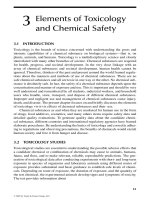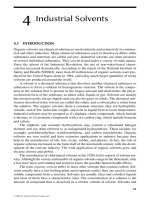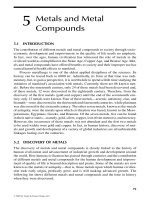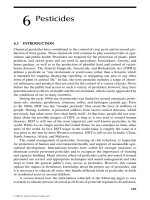SAFE USE OF CHEMICALS: A Practical Guide - Chapter 2 pdf
Bạn đang xem bản rút gọn của tài liệu. Xem và tải ngay bản đầy đủ của tài liệu tại đây (126.78 KB, 9 trang )
5
2
Chemical Substances
and Categorization
2.1 INTRODUCTION
Chemical substances include different classes and categories of materials. A very
broad categorization includes industrial solvents, metals and metal compounds,
pesticides, organic and inorganic dusts, fumigants, toxic gases, corrosive chemical
substances, asphyxiates, irritants, oxidizing agents, neurotoxicants, nephrotoxicants,
carcinogens, mutagens, and teratogens. More information on candidate chemical
substances of each group is provided in other pages of the book. The following pages
list, in brief, some of the chemical substances for easy identication and proper and
judicious use by workers.
2.2 CHEMICALS AND CATEGORIZATION
Chemical substances are many and the classications are several and elaborate. For
purposes of easy and ready identication by common users, chemical substances are
categorized as (1) industrial solvents; (2) metals and metal compounds; (3) pesticides;
(4) toxic dust, fumes, gases, vapors; (5) fumes and dust of metals; (6) asphyxiates;
(7) corrosive substances; (8) eye, skin, lung, and respiratory irritants; (9) neurotoxic
chemicals; (10) oxidizing agents; and (11) carcinogens, mutagens, and teratogens.
Chemical substances are also well classied as petrochemicals, drugs and pharmaceu-
ticals, food additives, colors and dyes, plastics, rubber, and many others. The details of
classications and grouping of chemical substances are available in the literature.
2.2.1 INDUSTRIAL SOLVENTS
Industrial solvents are chemical substances, usually liquid, that are commonly used
to dissolve unwanted substances or material. Solvents are liquids used for purposes
of mixing and to dissolve other substances, such as paints, greases, wax, and oils.
Solvents are found in fuels, adhesives, glues, cleaning uids, epoxy resins, harden-
ers, lacquers, paints, paint thinners, primers, and even nail polish removers. Pro-
longed periods of exposure to some solvents (such as acetone, alcohols, benzene,
gasoline, mineral spirits, methylene chloride, toluene, turpentine, and xylene) cause
acute and chronic health effects. Solvents are among the most frequently used indus-
trial chemicals because of their ability to clean grime and grease. Application of
different solvents in industries and homes is very common and has become a global
trend. Industrialization and, more particularly, polymers, paints, and coating indus-
tries use solvents in very large quantities around the globe. Human exposure to dif-
ferent solvents in workplace air and the general atmosphere is very common. The
© 2009 by Taylor & Francis Group, LLC
6 Safe Use of Chemicals: A Practical Guide
uses, manner of exposure, health effects, and environmental impact of different sol-
vents are discussed in other chapters of this book. More information is available in
the literature.
1–6
2.2.2 METALS AND METAL COMPOUNDS
Different metals and metal compounds have been in use since the beginning of
human civilization. Metals include aluminum, antimony, cobalt, copper, chromium,
iron, nickel, manganese, molybdenum, selenium, tin, vanadium, and zinc. The list of
toxic metals includes but is not limited to arsenic, beryllium, cadmium, hexavalent
chromium, lead, and mercury. Contamination of food, water, and the air by met-
als, particularly lead and cadmium, has caused global concern. Several studies have
shown elevated levels of lead, nickel, chromium, and manganese in children’s hair.
Occupational exposure to metals (metal fume fever [MFF]) causes acute and
chronic health disorders such as fever, headache, fatigue, cough, and a metallic taste.
Metal fumes in workplaces have close linkages with zinc oxide, magnesium, cobalt,
and copper oxide fumes. Prolonged periods of exposure to copper have also caused
its accumulation in liver, brain, kidney, and cornea, leading to the classic impairment
and stigmata of Wilson’s disease and Indian childhood cirrhosis. In fact, chronic
exposure to many of the heavy metals has been associated with human cancer. Many
toxic heavy metals (e.g., lead, manganese, and cadmium), combined with prenatal
or neonatal developmental insults and stress, have been reported to cause brain
damage and disturb the normal functioning of essential neurotransmitters. Details
on metals and health hazards are discussed in other pages of this book and in the
literature.
6–13
2.2.3 PESTICIDES
Pesticide is used to control pests of different kinds, such as target insects, vegeta-
tion, and fungi. Pesticides are known poisons used specically for the control of
crop pests and rodents. Some are very poisonous, or toxic, and may seriously injure
or even kill humans. Others are relatively nontoxic. Pesticides can irritate the skin,
eyes, nose, or mouth. The health effects of pesticides depend on the type of pesticide.
The organophosphate and carbamate pesticides affect the nervous system. Others
cause irritation to the skin, eyes, and mucous membranes. Several pesticides are
carcinogens and some others cause disturbances to the hormone or endocrine system
in the body.
Prolonged periods of exposure to high concentrations of pesticides cause (1) repro-
ductive effects, (2) teratogenic effects, (3) carcinogenic effects, (4) mutagenic effects,
(5) neurotoxicity, and (6) immunosuppression. The array of chemical substances
called pesticides is grouped under different classes: for instance, organophosphate
pesticides (OPPs), organochlorine pesticides (OCPs), carbamates, synthetic pyre-
throids, biopesticides, and microbial pesticides. The OPPs affect the nervous sys-
tem by disrupting the enzyme that regulates acetylcholine, a neurotransmitter. Many
of the OCPs are known for heavy persistence in the environment and are banned
or restricted from further use. The carbamate pesticides, like OPPs, also affect the
nervous system by disupting an enzyme that regulates acetylcholine. However, the
© 2009 by Taylor & Francis Group, LLC
Chemical Substances and Categorization 7
enzyme activity usually is reversible. The synthetic pyrethroids form the synthetic
version of the naturally occurring pesticide pyrethrin (found in chrysanthemums).
Some of the synthetic pyrethroids cause adverse effects to the nervous system.
More information on pesticides and health effects is available in the literature.
6–6c
It is alarming to note that, according to reports of the National Academy of Sciences
(NAS), in 1984 more than 67% of the then existing pesticides had not been properly
evaluated. The NAS observed that on the basis of data, the potential risks posed by
cancer-causing pesticides in our food are over one million additional cancer cases in
the U.S. population alone over the next 70 years.
13,14
2.2.4 TOXIC DUST, FUMES, GASES, AND VAPORS
The public and, more particularly, industrial workers in workplaces, are exposed to
different kinds and forms of toxic chemical substances—for instance, solids, liquids,
gases, vapors, dusts, fumes, bers, and mists. How a chemical substance gets into the
body and its effect on health depend on the form or the physical properties of the can-
didate chemical substance. Welding fumes are a complex mixture of metallic oxides,
silicates, and uorides. Many kinds of occupations, such as welding, cutting, and allied
processes, produce fumes and gases, leading to serious health effects on workers.
Fumes are solid particles that originate from welding consumables, the base
metal, and any coatings present on the base metal. Exposure to toxic fumes causes
irritation of eyes, skin, and the respiratory system and severe complications. Metal
fumes cause toxicity with symptoms such as nausea, headaches, dizziness, and MFF.
After chronic exposure to manganese fumes, industrial workers suffer deleterious
health effects such as impaired speech and gait. During welding on plated, galva-
nized, or painted metals, fumes get generated with cadmium, zinc oxide, or lead,
which are known toxicants. Toxic gases generated during material welding include
carbon monoxide, nitrogen dioxides, and ozone.
2.2.4.1 Fumes and Dust of Metals
Breathing the fumes generated from the heating of heavy metals may result in MFF,
which is characterized by irritation of the lungs, dry throat, chills, fever, and pain
in the limbs. Cadmium fumes may cause emphysema. Exposure to hydrocarbons,
chromium, beryllium, and arsenic fumes may cause lung cancer. The metal alloys
as sold in solid form are generally not considered hazardous. However, with differ-
ent processes, such as grinding, melting, cutting, and other activities, dust or fumes
and particulates are released to the work environment. The hazards caused by these
manufacturing activities become very serious, leading to metal poisoning and other
health effects. Inhalation of cobalt metal fume and dust may cause interstitial bro-
sis, interstitial pneumonitis, myocardial and thyroid disorders, and sensitization of
the respiratory tract and skin.
Inhalation of toxic substances represents the most common means by which inju-
rious substances enter the body. Air contaminants in the workplace present both acute
and chronic dangers to health. Inhalation of toxic substances can cause serious local
damage to the mucous membranes of the mouth, throat, and lungs or pass through
the lungs into the circulatory system, producing systemic poisoning at sites remote
© 2009 by Taylor & Francis Group, LLC
8 Safe Use of Chemicals: A Practical Guide
from the point of entry. Several thousand deaths per year are attributed to exposure to
dust, fumes, gases, vapors, and mist in the workplace. Exposure to organic dusts such
as coal dust can cause asthma, chronic bronchitis, and emphysema. Mineral dusts
such as asbestos can cause asbestosis, characterized by coughing and breathlessness,
or mesothelioma, a cancer of the lung lining. Exposure to toxic chemical dusts may
result in irritation, bronchitis, and cancer, depending on the nature of the chemical.
The poisoning effect may be rapid or slow, depending upon the amount of the sub-
stance inhaled and its toxicity, as well as the duration of exposure.
Exposure to acid and alkaline gases such as hydrochloric acid and ammonia will
cause extreme local irritation to the lungs. Some gases such as carbon monoxide may
pass into the blood stream and cause systemic injuries. Vapors are the gaseous state
of liquids. Inorganic vapors are generally harmless. Exposure to organic vapors,
however, may cause nose and throat irritation, pulmonary edema, or cancer. Mists
are ne suspensions of liquid in air and can cause chemical burns of the lungs, lung
disease, and cancer. Common mists include sulfuric acid and sodium hydroxide from
oven cleaners. The presence of environmental pollutants in the Arctic is particularly
troubling because the Arctic ecosystem is fragile and slow to recover from impacts.
Toxic chemicals accumulating in the Arctic include persistent organic pollutants
(POPs), such as DDT (dichloro-diphenyl-trichloroethane) and PCBs (polychlori-
nated biphenyls), and heavy metals, including mercury, cadmium, and lead. While
some heavy metals provide essential micronutrients, others are naturally toxic. All
metals have serious negative effects at high concentrations. For more information
refer to the literature.
6,15
2.2.5 ASPHYXIATES
Asphyxiates paralyze the respiratory center and weaken the body. They disturb the
maintenance of an adequate oxygen supply to different systems in the body. The
most common asphyxiates are carbon dioxide, carbon monoxide, cyanides, helium,
nitrogen, and nitrous oxide.
2.2.6 CORROSIVE SUBSTANCES
Corrosive chemical substances are those that cause visible destruction or permanent
changes in human skin tissue at the site of contact or are highly corrosive to steel.
These chemical substances on contact with living tissue or on leakage cause severe
damage. On contact with human tissue, most corrosive substances produce chemi-
cal burns, while certain substances, such as chromic acid, produce deep ulceration.
Many corrosive substances have a defatting action on the skin and may cause der-
matitis. Corrosive substances cause material damage during transport. Inhalation of
corrosive mists (or dusts) causes irritation and burns to the inner lining of the wind-
pipe and lungs. The majority of these are common basic chemicals used extensively
in all elds of industry.
In the rst instance, all corrosive chemical substances must be clearly labeled
with the correct chemical name. Corrosive chemical substances include strong acids,
bases and alkalis, dehydrating agents, halogens, organic halides, esters, and many
© 2009 by Taylor & Francis Group, LLC
Chemical Substances and Categorization 9
other substances. The concentrations of acids and bases and alkalis could be listed
as follows: acetic acid > 25% concentration, hydrochloric acid > 25% concentra-
tion, nitric acid > 20% concentration, chromic acid, hydrouoric acid, perchloric
acid > 10% concentration, sulfuric acid > 15% concentration, fuming sulfuric acid,
ammonium hydroxide > 35% by weight of gas, potassium hydroxide (caustic potash),
sodium hydroxide > 5% concentration, aluminum chloride, bromine, phosphorous
trichloride, potassium biuoride, sodium hypochlorite > 10% concentration, and
zinc chloride.
All containers, pipes, apparatuses, installations, and structures used in the manu-
facture, storage, transport, or use of these substances should be protected by suitable
coatings impervious to corrosives. All containers or receptacles should be clearly
labeled to indicate their contents and should bear the danger symbol for corrosives.
In Australia, the labeling of these containers should be in accordance with the
National Code of Practice for the Labeling of Workplace Substances, which replaces
the National Occupational Health and Safety Commission’s Guidance Note for the
Labeling of Workplace Substances. Adequate ventilation and exhaust arrangements,
whether general or local, should be provided whenever corrosive gases or dusts are
present. The most satisfactory method of ensuring worker protection and safety is to
prevent contact with corrosive substances and use suitable personal protective equip-
ment (PPE). Students and workers using corrosive substances must always wear eye
protection in the form of safety glasses.
2.2.7 IRRITANTS
Irritants are chemical substances or agents that cause inammation of the body sur-
face on contact. Irritant chemical substances cause changes in the mechanics of res-
piration and lung function and may cause adverse effects to the eyes, skin, throat,
and lungs (respiratory irritants).
2.2.7.1 Eye and Skin Irritants
Ammonia, alkaline dusts and mists, hydrogen chloride, hydrogen uoride, halogens,
nitrogen dioxide, ozone, phosgene, and phosphorous chloride can irritate the eyes
and skin.
2.2.7.2 Lung and Respiratory Irritants
Lung irritants cause damage to the pulmonary tissue. These include but are not lim-
ited to acetic acid, acrolein, formaldehyde, and formic acid and are classied as pri-
mary and secondary irritants. The primary irritants exert local effects—for example,
acid fumes cause burning effects on the lungs. Secondary irritants, such as mercury
vapors, cause local irritation as well as systemic effects after absorption. Prolonged
periods of lung irritation produce acute pulmonary edema. Symptoms include
shortness of breath and coughing that produces large amounts of mucous. Reac-
tions to some chemical substances also cause allergic sensitization with asthmatic-
type symptoms. It is important that users note that short-term exposure to irritant
© 2009 by Taylor & Francis Group, LLC
10 Safe Use of Chemicals: A Practical Guide
chemical substances is usually reversible and causes no permanent damage, while
systemic poisoning may persist and cause permanent damage.
The solubility of irritant gases inuences the degree of toxicity to lungs and
parts of the respiratory tract. For instance, gases such as ammonia, hydrogen chlo-
ride, and sulfur dioxide are readily soluble and cause irritation of the upper respira-
tory tract. In contrast, insoluble gases such as carbon monoxide and phosgene travel
deeply into the lungs and cause irritation of the bronchi and alveoli or air sacs. Soon
after absorption into the blood stream, these gases cause deleterious effects to vari-
ous organ sites. Exposure to chlorine and hydrogen sulde, for instance, affects the
entire respiratory tract.
2.2.8 NEUROTOXIC CHEMICALS
Exposure to neurotoxicants or neurotoxic chemical substances causes severe adverse
health effects to the nervous system, which is very sensitive to organometallic com-
pounds and sulde compounds. These compounds disrupt the normal functioning of
the central nervous system, peripheral nerves or sensory organs, and the conduction
of nerve impulses. Thus, chemical substances are considered neurotoxicants when
they induce a consistent pattern of neural dysfunction. The chemical substances
include but are not limited to carbon disulde, manganese, methyl mercury, organic
phosphorous insecticides, tetraethyl lead, thallium, and trialkyl tin compounds.
2.2.9 OXIDIZING AGENTS
Oxidizing chemicals are materials that spontaneously react and evolve oxygen at
room temperature or with slight heating, or promote combustion. Oxidizing chemi-
cals include peroxides, chlorates, perchlorates, nitrates, and permanganates. Strong
oxidizers are capable of forming explosive mixtures when mixed with combustible,
organic, or easily oxidized materials. These chemical substances require careful
handling, storage, and disposal. These chemical substances cause hazards of res,
explosions, injuries, and even death because of carelessness or negligence during
use.
It is well known that perchloric acid, a powerful oxidizing agent, reacts violently
and explosively with any organic compound or reducing agent. Strong oxidizing
agents, such as chromic acid, should be stored and used in glass or other inert, and
preferably unbreakable, containers. Also, for the storage of perchloric acid, corks or
rubber stoppers must never be used. Reaction vessels containing appreciable amounts
of oxidizing materials should never be heated in oil baths, but rather on a heating
mantle or sand bath. The primary hazard of oxidizing agents is the ability to act as an
oxygen source, which is especially hazardous during re situations. These materials
present a re and explosion hazard when in contact with organic or combustible mate-
rials. All contact with organic or combustible material must be avoided. In fact, the
primary consideration in the storage of these materials is that they must be isolated
from all ammable or combustible material. The common examples are chlorate,
permanganate, inorganic peroxide, nitrocarbonitrate, or a nitrate that yields oxygen
readily to stimulate the combustion of organic matter (see Tables 2.1 and 2.2).
© 2009 by Taylor & Francis Group, LLC
Chemical Substances and Categorization 11
TABLE 2.1
Oxidizing Chemical Substances and Agents
Aluminum nitrate
Ammonium permanganate
Ammonium perchlorate Potassium nitrate
Ammonium persulfate Potassium persulfate
Barium chlorate Potassium permanganate
Potassium dichromate Barium nitrate
Potassium bromate Zinc peroxide
Silver nitrate Sodium carbonate peroxide
Barium peroxide Sodium chlorate
Bromine Sodium perchlorate
Sodium chlorite Sodium nitrate
Sodium peroxide Sodium perborate
Sodium nitrite Sodium perborate tetrahydrate
Dibenzoyl peroxide Sodium dichloro-s-triazinetrione
Sodium dichromate Sodium persulfate
Sodium perchlorate monohydrate Calcium hypochlorite
Calcium chlorate Calcium peroxide
Calcium nitrate Chromic anhydride
Chlorine triuoride Cupric nitrate
Chromic acid Fluorine
Hydrogen peroxide (8–27.5%) Lithium hypochlorite
Lead nitrate Magnesium nitrate
Lithium peroxide Magnesium perchlorate
Magnesium peroxide Strontium chlorate
Strontium nitrate Strontium peroxide
Nickel nitrate Zinc chlorate
Nitric acid (<70% concentration) Nitrogen trioxide
Perchloric acid (<60% concentration)
TABLE 2.2
Oxidizing Liquids and Solids
Bromine Bromates
Chlorates Chlorinated isocyanurates
Dichromates Chromates
Hypochlorites Hydroperoxides
Ketone peroxides Inorganic peroxides
Nitric acid Nitrates
Perborates Nitrites
Perchloric acid Perchlorates
Permanganates Periodates
Peroxyacids Peroxides
Persulfates
© 2009 by Taylor & Francis Group, LLC
12 Safe Use of Chemicals: A Practical Guide
2.2.10 CARCINOGENS, MUTAGENS, AND TERATOGENS
Carcinogens are chemical substances capable of increasing the risk of cancer after
prolonged periods of exposure. Teratogens are hazardous chemicals capable of caus-
ing an increased risk of birth defects in children of exposed workers. Precautions
and prudent practices are very essential during the use of these chemical substances.
Some chemical substances have been classied as known carcinogens and teratogens,
while others are suspected carcinogens and teratogens. Students and workers must
reduce direct exposure to these chemical substances at all levels of work through
good work habits, responsibility, and common sense. Workers and work areas using
carcinogens, mutagens, and teratogens should be well equipped with proper proto-
cols for handling, storing, disposal, and emergency procedures.
2.2.11 CHEMICALS AND FIRE HAZARDS
Some of the ammable and combustible materials are categorized as:
class A: res in ordinary combustible materials (e.g., wood, cloth, paper, rub-
ber, and many plastics);
class B: res in ammable liquids, oils, greases, tars, oil-base paints, lacquers,
and ammable gases;
class C: res that involve energized electrical equipment where the electrical
conductivity of the extinguishing medium is of importance; when electri-
cal equipment is de-energized, extinguishers for class A or B res may be
safely used; and
class D: res in combustible metals such as potassium, sodium, lithium, mag-
nesium, titanium, and zirconium.
2.3 CONCLUSION
More information on different chemical substances, as well as the categorization,
kinds of uses, and possible health effects, is available in other chapters of this book
and in other published literature.
3,4,10,13,16–18
To protect themselves and the living
environment, students and workers must be well aware of potential toxicity and the
implications of negligence and improper use. The different chapters of this book dis-
cuss specic chemical substances and their uses, toxicity, health effects on animals
and humans, and the importance of taking precautions during use.
REFERENCES
1. Sittig, M. 1991. Handbook of toxic and hazardous chemicals, 3rd ed. Park Ridge, NJ:
Noyes Publications.
2. Sax, N. I., and Lewis, R. J. 1989. Dangerous properties of industrial materials, 7th ed.
New York: Van Nostrand Reinhold Company.
3. Flick, E. W. 1998. Industrial solvents handbook, 5th ed. New York: William Andrew
Publishing/Noyes.
4. Wypych, G. 2001. Handbook of solvents. Claremont, NH: Chem Tec Publishing.
© 2009 by Taylor & Francis Group, LLC
Chemical Substances and Categorization 13
5. Cheremisinoff, N. P. 2003. Industrial solvents handbook, 2nd ed. New York: Mar-
cel Dekker.
6. Dikshith, T. S. S., ed. 1991. Toxicology of pesticides in animals. Boca Raton, FL: CRC
Press.
6a. Kidd, H., and James, D. R., eds. 1991. The agrochemicals handbook, 3rd ed. Cam-
bridge, U.K.: Royal Society of Chemistry Information Services.
6b. Dikshith, T. S. S., and Diwan, P. V. 2003. Industrial guide to chemical and drug safety.
Hoboken, NJ: John Wiley & Sons Inc.
6c. Hayes, W. J., and Laws, E. R., eds. 1991. Handbook of pesticide toxicology. New York:
Academic Press.
7. U.S. Department of Labor, Occupational Safety & Health Administration (OSHA).
2007. Toxic metals. Washington, D.C.: Occupational Safety & Health Administration.
8. Goyer, R. A., ed. 1995. Metal toxicology. New York: Academic Press.
9. Klaasen, C. D., and Doull, J. 2001. Casarett and Doull’s toxicology: The basic science
of poisons, 6th ed., ed. M. O. Amdur, J. Doull, and C. D. Klassen. New York: McGraw-
Hill.
10. National Research Council (NRC). 1995. Prudent practices in the laboratory handling
and disposal of chemicals. Washington, D.C.: National Academy Press.
11. Goyer, R. A. 1997. National Institute of Environmental Health Sciences. Toxic and
essential metal interactions. Annual Review of Nutrition 17: 37–50.
12. Goyer, R. A. 1995. Nutrition and metal toxicity. American Journal of Clinical Nutrition
61 (Suppl 3): 646S–650S.
13. Lewis, M., Worobey, J., Ramsay, D. S., and McCormack, M. K. 1992. Prenatal expo-
sure to heavy metals: Effect on childhood cognitive skills and health status. Pediatrics
89 (6 Pt 1): 1010–1015.
14. National Academy of Sciences. 1987. Regulating pesticides in food: The Delaney para-
dox. Washington, D.C.: National Academy Press.
15. Warren, P. 1997. Hazardous gases and fumes—A safety handbook. Amsterdam: Elsevier.
16. National Institute for Occupational Safety and Health (NIOSH). 1992. Recommenda-
tions for occupational safety and health: Compendium of policy documents and state-
ments. Cincinnati, OH: U.S. Department of Health and Human Services, Public Health
Service, Centers for Disease Control, NIOSH Publication No. 92-100.
17. American Conference of Governmental Industrial Hygienists (ACGIH). 1994–1995.
Threshold limit values for chemical substances and physical agents and biological
exposure indices. Cincinnati, OH: ACGIH.
18. Agency for Toxic Substances and Disease Registry (ATSDR). 1998. Toxicological pro-
le for sulfur dioxide. Atlanta, GA: U.S. Department of Health and Human Services,
Public Health Service (updated 1999).
© 2009 by Taylor & Francis Group, LLC









